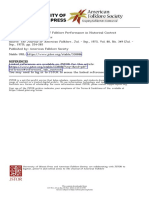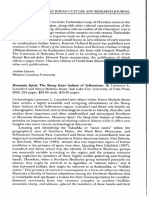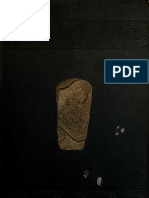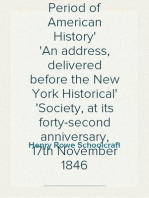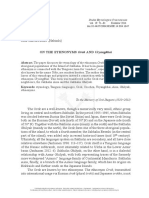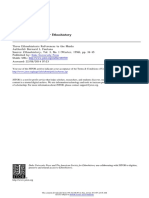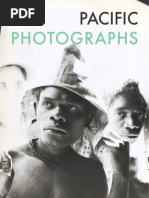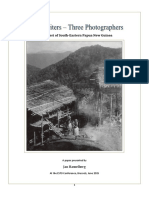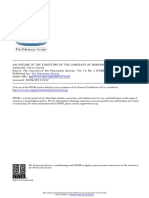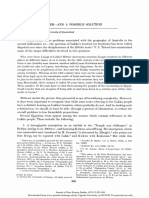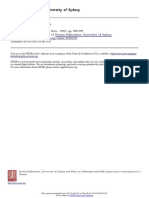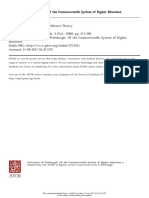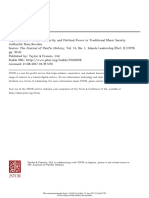The American Society For Ethnohistory: Duke University Press
The American Society For Ethnohistory: Duke University Press
Uploaded by
Mariusz KairskiCopyright:
Available Formats
The American Society For Ethnohistory: Duke University Press
The American Society For Ethnohistory: Duke University Press
Uploaded by
Mariusz KairskiOriginal Title
Copyright
Available Formats
Share this document
Did you find this document useful?
Is this content inappropriate?
Copyright:
Available Formats
The American Society For Ethnohistory: Duke University Press
The American Society For Ethnohistory: Duke University Press
Uploaded by
Mariusz KairskiCopyright:
Available Formats
The American Society for Ethnohistory
The Historic Indian of the Ohio Valley: An Archaeologist's View
Author(s): Glenn A. Black
Source: Ethnohistory, Vol. 1, No. 2 (Nov., 1954), pp. 155-165
Published by: Duke University Press
Stable URL: http://www.jstor.org/stable/480372 .
Accessed: 22/06/2014 13:37
Your use of the JSTOR archive indicates your acceptance of the Terms & Conditions of Use, available at .
http://www.jstor.org/page/info/about/policies/terms.jsp
.
JSTOR is a not-for-profit service that helps scholars, researchers, and students discover, use, and build upon a wide range of
content in a trusted digital archive. We use information technology and tools to increase productivity and facilitate new forms
of scholarship. For more information about JSTOR, please contact support@jstor.org.
Duke University Press and The American Society for Ethnohistory are collaborating with JSTOR to digitize,
preserve and extend access to Ethnohistory.
http://www.jstor.org
This content downloaded from 188.72.126.41 on Sun, 22 Jun 2014 13:37:40 PM
All use subject to JSTOR Terms and Conditions
printedfrom the Ohio State Archaeologicaland
storical Quarterly, Vol. 63, No. 2, April, 1954
THE HISTORIC INDIAN OF THE OHIO VALLEY:
AN ARCHAEOLOGIST'S VIEW
by GLENN A. BLACK
I think I should take the liberty of altering the title of this paper
as it appears on the program from "The" Archaeologist's View to
"An" Archaeologist's View. This for the simple reason that what
I shall say is based largely upon personal experience and observa-
tions and may not therefore properly reflect the attitude of my
archaeological and historical colleagues as a collective group. I
must say at the very outset that we in Indiana have long been in-
terested in the Indian of history and especially that phase of Indian
history which constitutes the theoretical approach to his prehistoric
past. This interest goes back at least to the year 1935, when, at
Indianapolis, a meeting was held under the auspices of the National
Research Council for the purpose of "discussing the technical
problems relating to the comparative study of the archaeological
cultures in the upper Mississippi Valley and Great Lakes Region."
The major portion of the three-day session was devoted to dis-
cussion of just what constituted Hopewell, Woodland, Middle
Mississippi, and so forth, all of which were, and are, archaeological
problems which need not concern us here. Throughout the meeting,
however, intermixed with comments pertaining strictly to archae-
ological manifestations, the question of historical tribes and ethnic
groups kept creeping in. Among the discussants there were repre-
sentatives of the states of Wisconsin, Iowa, Minnesota, Illinois,
Indiana, Michigan, Ohio, Kentucky, and New York. Others were
in the nature of "delegates at large," and to the latter group should
go most of the credit for what thought was given to historic tribes
of the area. Specific mention of Indian tribes by name, in connection
with late archaeological complexes, was made by only two persons
in detailing their problems on a state basis, Keyes of Iowa and
Ritchie of New York, and it should be noted that neither are
from the Ohio Valley proper. The meeting closed with the thought
155
This content downloaded from 188.72.126.41 on Sun, 22 Jun 2014 13:37:40 PM
All use subject to JSTOR Terms and Conditions
156 OhioStateArchaeological
and HistoricalQuarterly
that there was definitely a need for ethnographic and historical
research in the area as an adjunct to archaeology.
It was in keeping with the spirit of that meeting, therefore,
that the Indiana Historical Society decided to spend at least two
normal archaeological seasons in an attempt to approach the pre-
history of our state from the horizon of initial European-Indian
contact. The years 1936 and 1937 were thus spent, and it is upon
the basis of that experience to a certain extent that this paper
is written.
Prior to entering the field in the spring of 1936 the winter was
spent in a search of the literature pertaining to the beginnings of
recorded history in Indiana. This literature dealt with northern
Indiana, of course, for it was there that the first Europeans of
record were active.
It soon became evident that the documentary backgroundcould
be roughly divided into two type and period groups. The earliest
of these were the records of French activity, and the later group
pertained to the actual settling of the land by the ultimately per-
manent colonists.
The earliest records pertain to exploratory expeditions, either
military, clerical, or commercial,sent out to establish contacts with
the natives of the Illinois country beginning with LaSalle in 1679.
These are followed by the accounts of priests, the correspondence
of post commanders, and the narratives of traders and travelers
through the region. All of them relate, more or less, to the establish-
ment and maintenance of the French posts along the Wabash
River and the St. Joseph of Lake Michigan. Unfortunately for us,
these source materials cover a period when the French were doing
their utmost to establish their military and commercial lines from
the St. Lawrence to the Gulf of Mexico. They cover a period when
the Indians of the area were in a state of extreme unrest, suffering
from peripheral impacts of similar contacts between whites and
aborigines farther to the east. Wholesale transplantation of entire
tribal groups from one region to another by the French is a matter
of record, and the setting up of hatreds within linguistically re-
lated groups is more than intimated in many of the documents.To
This content downloaded from 188.72.126.41 on Sun, 22 Jun 2014 13:37:40 PM
All use subject to JSTOR Terms and Conditions
Ohio Valley Historic Indian Conference 157
carry out their plans the French stopped at nothing. It was an era
of "backbiting,"when intrigue was met with counter intrigue, move
against move, with the Indian acting always as the pawn. Deliberate
exaggeration and falsification were the means resorted to in order
to gain favor at court, and few travel narratorscould hope to become
the author of a best seller unless some vast and Gulliveresque dis-
covery was expounded to an eager public.
With few exceptions the maps of the period are a series of
compounded errors delineated by cartographers who had never
seen the country they were portraying. Too often there are two or
more accounts by one person of one event which do not agree with
each other. Often two or more individuals record a single event
without agreement with each other. Which is to be relied upon,
and how wrong would we be if all accounts except one had become
lost, as many of them have? So far as northern Indiana is con-
cerned it is not possible, so far as we have been able to determine,
to establish an exact date for the founding of any one of the
French posts involved. After two years spent in researchboth in the
field and in institutions, the conclusion that the establishmentscame
about too late to provide data of a truly "contact" nature is an
unavoidable one. The Indian was no longer living an aboriginal
way of life, in the material sense, in the closing years of the
seventeenth century in northern Indiana. Content of graves which
must represent those Indians brought to the present Fort Wayne
by the French when they established their first post at that place,
is not aboriginal in nature, it is European. Glass beads, kaolin
pipes, brass kettles, and objects made of iron had by then replaced
completely the prototypes of stone, bone, or clay. True contact
then, between European and Indian, that nebulous starting point
for the search into the significance of prehistory, was not to be
found in Indiana. The Indian had had trade relations with whites
for many years elsewhere.
The second series of documents pertain in general to the period
beginning about 1800. By this time records were more or less
precise, and through the medium of land surveys many sites then
being lived upon by Miami, Potawatomi, or Wea in northern
This content downloaded from 188.72.126.41 on Sun, 22 Jun 2014 13:37:40 PM
All use subject to JSTOR Terms and Conditions
158 OhioStateArchaeologicaland HistoricalQuarterly
Indiana, can be located within a matter of feet today. This is an
interesting period and one replete with facts and data of interest
both to the ethnologist and the historian but of no value to the
archaeologist in his attempt to push back from the known into
the unknown. It would be surprising indeed if material traits of a
group of Miami of the year 1800 should be aboriginal in nature
when those of their ancestors of one hundred years before were
completely European.
Items of trade, such as glass beads, brass and iron objects, kaolin
pipes, silver ornaments, and so forth, constitute in themselves a
fascinating field for study. They have value to both the historian
and the archaeologist in at least period-datinghistorical sites. They
do not, however, have any weight when it comes to using them for
precise dates, for ethnic associations,or for determining the national
affiliationsof the trade goods source. As an example of their value,
items such as these were used to corroboratethe documented fact
that two posts were erected on the Maumee at Fort Wayne by the
French at two different times. Trade objects of an earlier type were
found at the alleged site of the earlier post and objects of later
type were found at the alleged second site. From none of these
objects, however, would it be possible to determine the exact date
of the founding of the first or second posts or whether the tradors
were French or British or the tradees Miami, Potawatomi, Wea,
or Ottawa. The same items were traded by all traders to all
Indians of a similar area over comparativelylong periods of time.
Further,some of these objects were possibly kept as heirlooms and
found a final resting place in a grave with an individual perhaps
one, two, or three generations removed from the original owner.
At the end of 1937 the archaeological program in Indiana re-
verted to the problems of prehistory rather than protohistory. We
did not, however, lose interest in the concept of the historical
approach to prehistory or in the Indian of history. The interest
has been sustained over a long period through the medium of a
migration legend which we feel has some bearing upon Indiana
prehistorybut for the solution of which a starting point had to be
made outside the Ohio Valley.
This content downloaded from 188.72.126.41 on Sun, 22 Jun 2014 13:37:40 PM
All use subject to JSTOR Terms and Conditions
Ohio Valley Historic Indian Conference 159
The legend in question is that of the Delaware Indians and is
known in the literature as the Walam Olum. Initial interest in the
legend was motivated as much by the possibility of focusing the
several disciplines of anthropology upon a common problem as in
establishing the validity of the story itself. Internal evidence seemed
to preclude the possibility of its being an intentional fabrication
by someone, either Indian or Caucasian. Studies of all aspects of
the legend were instituted. These included linguistics, ethnology,
the pictographs, physical anthropology, history, and archaeology.
The question of how much archaeology and physical anthropology
could contribute hinged, of course, largely upon what could be
learned from history and ethnology.
At the beginning of recorded history the Delaware were dwellers
of the Atlantic coastal area, and it was with the Delaware and
closely related kindred that the first intensive contacts between
Europeans and aborigines of northeastern North America were
made. When the program of study was inaugurated, therefore, it
seemed that here we had an exceptional opportunity for putting
the theory of a historical approach to prehistory to the test with
every reason to look forward to success. We felt that the Delaware
had perhaps lived in Indiana at some time in the prehistoric past.
We knew that they had dwelt in the central part of the state at a
late date, their towns being well documented, and their locations
can be visited with ease and assurancetoday, but they would never
produce material of assistance in projecting the history of this folk
back into the prehistoric past. But the eastern sites were being
lived upon when the first Europeansarrived,and since they had had
no previous opportunity for cultural adulteration,the materials from
these sites when identified as Delaware would form the pattern to
be followed in tracing the movements of this group into the past.
This was the ideal.
In the early 1930's a perusal of the literature pertaining to the
prehistory of the Atlantic coastal area revealed that most sites
were referred to as Algonquian or Iroquois and definitive tables of
traits were available which set up the criteria to be used in dis-
tinguishing the one from the other. It ultimately developed that
This content downloaded from 188.72.126.41 on Sun, 22 Jun 2014 13:37:40 PM
All use subject to JSTOR Terms and Conditions
160 Ohio State Archaeological and Historical Quarterly
no sites of undisputed Algonquian affinity were known, and the
term Algonquian was dropped in favor of the less definitive term
Woodland, this being one of the "labels" of classificatorytermin-
ology. The ethnic words Iroquois and Iroquioan seem to have
escaped the oblivion which came to Algonquian, in spite of the
fact that it is often equally questionable whether materials still
called Iroquois were actually made by Iroquois-speaking people.
In any event, it was hard to believe that an indisputable Delaware
site could not or had not been found, and to put incredulityto the
test a group of specialists was engaged by the Indiana Historical
Society to devote their energies to locating a contact Delaware
site or sites. They worked faithfully, some of them for as long as
four years, but at the conclusion of their project no Delaware
dwelling site of the contact period could be identified as such
without question. The reasons for this failure do not rest with the
individuals but with the shortcomings of the material with which
they worked.
The historical location of the Delaware was midway between the
two earliest settlements of whites on the coast-Jamestown, 1607,
and Plymouth, 1620. Intimate and continued contacts were made
with the Delaware by the Dutch and Swedes as early as 1614 to
1638. Following the initial contacts, which were often of the most
transitory sort, communicationand relations with these Indians in-
creased at a rapidly accelerating rate until before long aboriginal
culture had been broken down and the Indians themselves forced
from their native habitat. For a brief interval, perhaps no greater
than from initial contact until a permanent colony was established
in the state of Delaware in 1638, there was an opportunityon the
part of Europeans to record in detail the native culture of the
Delaware and to make a matter of record the location of those
sites where they were then living. By the year 1700 it is highly
probable that the few Indians remaining in their original places
of abode were no longer living an aboriginal life so far as material
things are concerned.These points are raised here for the very good
reason that in order to approachprehistory from history the archae-
ologist is dependent entirely upon the records left by those who
This content downloaded from 188.72.126.41 on Sun, 22 Jun 2014 13:37:40 PM
All use subject to JSTOR Terms and Conditions
Ohio Valley Historic Indian Conference 161
first contacted and observed the Indian in his natural environment.
In order to identify a projectile point type, or an axe, or a gorget,
or a method of decorating pottery vessels as being Delaware, some
individual would have had to specifically describe those objects
in detail which were being made and used by the Delaware. The
record should also indicate where the observations were made, and
describe the spot in such a way that the site could be located today
and excavated for verification of the recorded statements. This, it
is sad to report, was seldom if ever done.
Those who first contacted, either briefly or at length, the Indians
of the Delaware Bay and River area were not ethnologists. Nor
were they historians, or geographers, or cartographers.Their motive
was the discovery of new lands which could be colonized and ex-
ploited. The area around Lewes, Delaware, may be cited as an
example of the difficulties involved in our study. This, if we may
take any stock whatever in early recorded history, was most cer-
tainly Algonquian country in the 1630's and it probably was oc-
cupied by the Delaware-speaking Indians. In 1631, under Dutch
sponsorship, a small colony was established on Blommaert's Kil at
the present site of Lewes. A brick house surrounded by palisades
was erected for the accommodation of the thirty-three people in-
volved in the adventure.To prepare the way for this establishment
a strip of land some thirty-twomiles in length had been purchased
from the aboriginal holders in the year 1629. This strip, two miles
wide, extended from Bombay Hook south to Cape Henlopen along
the west side of Delaware Bay. The sale was confirmed in 1630
and documents are available which indicate that an Indian village
was then located on the "Southhookof Southriverbay."This would
have to be at or very near the present town of Lewes. The docu-
ments contain Indian names which undoubtedly are those of im-
portant personages connected with the village mentioned and one
of the words may be the name of the village itself. But what village,
and where was it located exactly, and what was the ethnic identity
of the occupants? These are matters left entirely to conjecture by
those who prepared the documents.
Maps of the area were subsequently made by deVries and
This content downloaded from 188.72.126.41 on Sun, 22 Jun 2014 13:37:40 PM
All use subject to JSTOR Terms and Conditions
162 Ohio State Archaeological and Historical Quarterly
Herman, and these show stylized symbols for Indian dwellings, but
the scale of the maps prevents location of the village with any
accuracy.The village must have been at or very near to Lewes, and
it probably was occupied by Alonquian-speakingIndians, and if so
they were probably Delaware. It would be pleasant to say with
assurance that these were not merely possibilities, for at and near
Lewes there are some important archaeologicalsites, some of which
have been excavated. Materials accruingfrom these excavations are
of the type which one would think of as being Algonquian of the
late prehistoric period. And, I might add, they were once so
designated.
But even if it were possible to say with assurance that one of
these sites was the one referred to in the 1630 documents, it would
still be impossible to document the type of dwelling, how they
buried their dead, the type of pottery they made and how they
decorated it, or the type of projectile point they used. The 1630
negotiators and the 1631 colonists failed to make such information
a matter of record, and it is these very things which are necessary
for the archaeologist to confirm the correctnessof recorded history
and to project back into time the pattern of life thus established.
Not only were the colonists interestedin other things, they probably
were completely occupied with mattersof more immediate concern,
for within a year the colony was eliminatedby Indian activity.
From the year 1638 to the end of Indian life in the area there
was a considerable body of information recorded relative to these
folk of Delaware Bay. Much of it is excellent ethnographic data
but very little of it has archaeologicalvalue, as can be verified by
reference to the work of Flannery and Kinietz, to cite only two
of several such compilations.
A modem tabulation of traits assignable to an ethnic group, such
as the Coastal Algonquian, will be a composite of items derived
from early sources such as those of the first Europeans, data from
subsequent time periods up to the time of extinction of aboriginal
life in the area being studied, data extracted from living Indians,
and finally, and paradoxically, traits which are strictly archaeological
in nature. Such a list, when all of these sources are combined, is
This content downloaded from 188.72.126.41 on Sun, 22 Jun 2014 13:37:40 PM
All use subject to JSTOR Terms and Conditions
Ohio Valley Historic Indian Conference 163
impressiveand revealing to the ethnologist and historian. It is far
less usable by the archaeologist. Perusal of such a list of traits will
immediatelyreveal the fact that a very small percentageof them are
of a type to be identifiable archaeologically. Most of them are
social and religious in characterand many of the included material
traits are vague, indefinite, and of a highly perishable nature. To
explain further, it may be pointed out that basketry is usually a
part of such a list. What kind of basketry,what were the materials
used, what was the characteristic shape, and was the basket dis-
tinctive as compared to other ethnic and linguistic groups in the
same area? What were the design motifs and how were they ap-
plied? The answers are seldom given in detail, and even if they
were it would not be too helpful to the archaeologist,since baskets
are rarely if ever found preserved in eastern archaeological sites.
Pottery is usually mentioned as being made by these protohistoric
tribes. But what kind of pottery, what was the temper, the shape,
the design motif, the character of appendages, or how was the
design applied to the vessel surface? Occasionally a highly diag-
nostic trait will be included in such an ethnographic listing. An
example would be the so-called "semi-lunarknife" of stone. Such
an inclusion in a trait list might be consideredas being Alonquian,
and it may well be. But its inclusion in an ethnographic trait list
is not based upon historical or known ethnic grounds, since this
type of object comes from an archaeological context which itself
cannot be associated with any language group in the area. Ethnic
studies then are usually somewhat of a disappointment so far as
the archaeologist is concerned.
The maps of the area were not of specific value. They were
generallyon a large scale and usually lacked definitive geographical
data which, even though an Indian village might be indicated
thereon, would permit its identification and location today. Even
in those rare instances where an early map showed a village site
in relation to some identifiable geographical feature which permits
of its modern location, such a town or village is seldom named so
that linguistic affinity of the occupants can be determined with
assurance.There are exceptions, fortunately, to these general de-
This content downloaded from 188.72.126.41 on Sun, 22 Jun 2014 13:37:40 PM
All use subject to JSTOR Terms and Conditions
164 Ohio State Archaeological and Historical Quarterly
ficiencies but they are few in number. I only know of one good
exception-Patawomeke of John Smith.
Still one more factor mitigated against the historical approach
to our eastern problem. In no other area of these United States has
there been such intensive urbanization and industrializationas in
the Long Island Sound, Delaware Bay and River, and Chesapeake
Bay areas. It is almost axiomatic that modern cities and towns are
built upon the sites of proto- and prehistoric habitation sites. The
East is no exception, except the area is larger and more completely
covered than elsewhere. It is little wonder, then, that after four
years of intensive and serious effort our workers in the East were
forced to the admission that they still could not identify a proto-
historic Delaware habitation site.
Failure in Indiana and a like experience in the East promptedan
examination of the archaeological literature of the area east of
the Mississippi since the time of the Indianapolis conference.This,
to see if others had met with the same experiences as had our group,
and if not, to determine just how we had fallen down. During
these years there have been some monumental works made avail-
able. Swanton's study of the DeSoto expedition, Webb's several
magnificent reports on research in the Tennessee Valley, Lewis and
Kneberg's Hiwassee Island, Griffin's Fort Ancient Aspect, Cole's
Kincaid Site, the co-authored Survey of the Alluvial Valley of the
Mississippi, and, still more recently, the Cole volume edited by
Griffin. Among these reports there are manifestations of culture
involved which approach the time of recorded history very closely
if indeed they do not extend well into that period. Yet the success
achieved, through a serious attempt in some cases, to correlate the
archaeological complexes with some linguistic group known to
have been living in the respective areas at the beginning of history
is not outstanding. It seems more than strange that of the many
sites visited by DeSoto in 1539-42 none of them have been iden-
tified with any real degree of assurance so far. And this was cer-
tainly one of the best documented expeditions coming within our
sphere of interest. And equally certain, Swanton exhausted every
possibility of making the identities sharp and precise.
This content downloaded from 188.72.126.41 on Sun, 22 Jun 2014 13:37:40 PM
All use subject to JSTOR Terms and Conditions
Ohio Valley Historic Indian Conference 165
In the Cole volume only three of the chapters, among those
representingthe Ohio Valley, contain references to historical groups
in connection with archaeological manifestations, and only one of
these really injects life into the otherwise completely inert arti-
factual data.
Long ere this I am sure that you will all agree that this archae-
ologist's view of the relationship of prehistory to history is of a
decidedly jaundiced hue. You will also more properly understand
my initial suggestion that the title be changed from "the" to "an"
archaeologist's view. This decidedly pessimistic attitude is based
upon personal experience, and it is recounted here for the purpose
of underscoring the need for a study such as the one proposed by
the composite group represented upon this program. The archae-
ologist is perhaps no better fitted to do the historical research lead-
ing up to the so-called historical approach than is the average
historian fitted to properly excavate a mound or .village site. An
organization like the one proposed may be the answer, it seems to
me, to at least some of the reasons for the presence of that sharp
definitive line which now exists between history and prehistory.
The line can only be crossed and the barriersremoved by collective
and cooperative work.
We are terrificallyhandicappedin the Ohio Valley by reason of
the lateness and paucity of historical records. Further, we are
handicappedby the apparentdegree of disparitybetween the mound
cultures and the Indiansof the same area at the beginning of history.
This is a psychological barrier of some import. And as an added
handicap I would suggest that the nomenclature of taxonomy has
become so convenient to use that we literally hide our doubts
behind the mantle of ambiguitywhen we call something Woodland
which otherwise might well be Algonquian, or Upper Mississippi
when in reality Iroquoian is intended. None of us, of course, can
at this late date correct the deficiencies of an inadequate docu-
mentation. But we can make a more intensive and intelligent use of
what has been left to us. I am sure that the archaeologist can con-
tribute much to the understandingof the Indian of history. In so
doing he would not be entirely unselfish, for he perhaps would have
more to gain than even the historian.
This content downloaded from 188.72.126.41 on Sun, 22 Jun 2014 13:37:40 PM
All use subject to JSTOR Terms and Conditions
You might also like
- Bruce G Trigger-Natives and Newcomers - Canada's - Heroic Age - Reconsidered-McGill-Queen's University Press (1985)Document445 pagesBruce G Trigger-Natives and Newcomers - Canada's - Heroic Age - Reconsidered-McGill-Queen's University Press (1985)HugoBotello67% (3)
- Holocaust of Giants PDFDocument19 pagesHolocaust of Giants PDFfufitron100% (4)
- A Model For The Analysis of Folklore Performance in Historical ContextDocument13 pagesA Model For The Analysis of Folklore Performance in Historical ContextAna Savić100% (1)
- Grave Matters: The Controversy over Excavating California's Buried Indigenous PastFrom EverandGrave Matters: The Controversy over Excavating California's Buried Indigenous PastNo ratings yet
- (1902) Archaeological History of Ohio: The Mound Builders and Later Indians (Lost Civilizations)Document788 pages(1902) Archaeological History of Ohio: The Mound Builders and Later Indians (Lost Civilizations)Herbert Hillary Booker 2nd100% (10)
- Mountain Spirit The Sheep Eater Indians of Yellowstone.Document4 pagesMountain Spirit The Sheep Eater Indians of Yellowstone.Pedro Henrique LeiteNo ratings yet
- Trigger. Etnohistory and ArchaeologyDocument8 pagesTrigger. Etnohistory and ArchaeologyAgustina LongoNo ratings yet
- The North Carolina Experience: An Interpretive and Documentary HistoryFrom EverandThe North Carolina Experience: An Interpretive and Documentary HistoryNo ratings yet
- Trio in SurinameDocument17 pagesTrio in SurinameMariusz KairskiNo ratings yet
- ERP22VL, 25VL, 30VL, 35VL (A976) Parts Manual: Yale Europe Materials Handling LimitedDocument480 pagesERP22VL, 25VL, 30VL, 35VL (A976) Parts Manual: Yale Europe Materials Handling LimitedЕвг67% (3)
- Application Rebuilding Kits: Kit BulletinDocument2 pagesApplication Rebuilding Kits: Kit Bulletinhidraulic100% (1)
- Airline JavaDocument11 pagesAirline JavaRoger BaltazarNo ratings yet
- The Making of The Maori - Culture Invention and Its LogicDocument14 pagesThe Making of The Maori - Culture Invention and Its LogicCarola LalalaNo ratings yet
- The Indian Tribes of The United StatesDocument631 pagesThe Indian Tribes of The United Stateslibrary364No ratings yet
- Andean Past Volume 5 OptimizedDocument420 pagesAndean Past Volume 5 OptimizedLuis Flores Blanco100% (1)
- The Mythology of Native Americans: Legends of Cherokee, Iroquois, Navajo, Siouan and ZuñiFrom EverandThe Mythology of Native Americans: Legends of Cherokee, Iroquois, Navajo, Siouan and ZuñiNo ratings yet
- (1890) Pre-Historic America (Lost Civilizations)Document454 pages(1890) Pre-Historic America (Lost Civilizations)Herbert Hillary Booker 2nd100% (13)
- Aboriginal American LiteratureDocument164 pagesAboriginal American LiteratureGutenberg.orgNo ratings yet
- HANSON - The Making of The MaoriDocument14 pagesHANSON - The Making of The MaoriRodrigo AmaroNo ratings yet
- Anticolonial Homelands Across The Indian Ocean: The Politics of The Indian Diaspora in Kenya, Ca. 1930-1950Document27 pagesAnticolonial Homelands Across The Indian Ocean: The Politics of The Indian Diaspora in Kenya, Ca. 1930-1950valdigemNo ratings yet
- James Rice - Into The Gap Ethnohistorians, Environmental History, and The Native SouthDocument24 pagesJames Rice - Into The Gap Ethnohistorians, Environmental History, and The Native SouthdecioguzNo ratings yet
- Argumentative EssayDocument4 pagesArgumentative EssayRose Jay VidalNo ratings yet
- Historyof Barbadosreview Stoffle 1972Document4 pagesHistoryof Barbadosreview Stoffle 1972Den VerNo ratings yet
- 02 Reid and WhittleseyDocument6 pages02 Reid and WhittleseyivanNo ratings yet
- Native American Mythology: Myths & Legends of Cherokee, Iroquois, Navajo, Siouan and ZuñiFrom EverandNative American Mythology: Myths & Legends of Cherokee, Iroquois, Navajo, Siouan and ZuñiNo ratings yet
- The HittitesDocument36 pagesThe HittitesOliverNo ratings yet
- Cosmogonic MythsDocument8 pagesCosmogonic MythsOsvaldo JoséNo ratings yet
- Colonial Expeditions to the Interior of California Central Valley, 1800-1820From EverandColonial Expeditions to the Interior of California Central Valley, 1800-1820No ratings yet
- HANSON The Making of The Maori PDFDocument14 pagesHANSON The Making of The Maori PDFMiguel Aparicio100% (1)
- (1892) The Mound Builders: Their Works and Relics (Lost Civilizations)Document454 pages(1892) The Mound Builders: Their Works and Relics (Lost Civilizations)Herbert Hillary Booker 2nd100% (14)
- American Indian CultureDocument23 pagesAmerican Indian CultureAlexandra Sept100% (1)
- Murra Social Structural and Economic ThemesDocument14 pagesMurra Social Structural and Economic ThemesAlexis Flores CórdovaNo ratings yet
- American Philosophical SocietyDocument12 pagesAmerican Philosophical Societyraz1355No ratings yet
- IndologistsDocument253 pagesIndologistsEduardo RossiNo ratings yet
- Historical Archaeology in Global PerspectiveDocument4 pagesHistorical Archaeology in Global PerspectiveDiego Jofré NavarreteNo ratings yet
- Hiawatha and the Iroquois Confederation A Study in Anthropology. A Paper Read at the Cincinnati Meeting of the American Association for the Advancement of Science, in August, 1881, under the Title of "A Lawgiver of the Stone Age."From EverandHiawatha and the Iroquois Confederation A Study in Anthropology. A Paper Read at the Cincinnati Meeting of the American Association for the Advancement of Science, in August, 1881, under the Title of "A Lawgiver of the Stone Age."No ratings yet
- Cambridge University Press American AntiquityDocument8 pagesCambridge University Press American AntiquityCamsNo ratings yet
- A Migration Legend of The Creek Indians, With A Linguistic, Historic and Ethnographic IntroductionDocument230 pagesA Migration Legend of The Creek Indians, With A Linguistic, Historic and Ethnographic IntroductioncharlotteciaNo ratings yet
- Appletons' Popular Science Monthly, Volume 54, November 1898From EverandAppletons' Popular Science Monthly, Volume 54, November 1898No ratings yet
- Everyday Life of the North American IndianFrom EverandEveryday Life of the North American IndianRating: 4 out of 5 stars4/5 (4)
- Orisha Journey PDFDocument20 pagesOrisha Journey PDFOmoOggunNo ratings yet
- Knowing Philippine HistoryDocument14 pagesKnowing Philippine HistoryRonel ResurricionNo ratings yet
- Indians Old WorldDocument25 pagesIndians Old WorldPopopopopoNo ratings yet
- Antlaropologist: MericanDocument2 pagesAntlaropologist: MericanMichael TipswordNo ratings yet
- Native American Culture Thesis StatementDocument5 pagesNative American Culture Thesis Statementafkodpexy100% (2)
- Incentives to the Study of the Ancient Period of American History An address, delivered before the New York Historical Society, at its forty-second anniversary, 17th November 1846From EverandIncentives to the Study of the Ancient Period of American History An address, delivered before the New York Historical Society, at its forty-second anniversary, 17th November 1846Rating: 5 out of 5 stars5/5 (1)
- Cornell-Notes 4Document3 pagesCornell-Notes 4chinhxaydung3No ratings yet
- The Historiography of New France and The Legacy of Iroquois InternationalismDocument19 pagesThe Historiography of New France and The Legacy of Iroquois InternationalismbasquitjNo ratings yet
- Gaia Servadio - em - Motya - Unearthing A Lost Civilization - emDocument4 pagesGaia Servadio - em - Motya - Unearthing A Lost Civilization - emxiaobaituNo ratings yet
- 4895 4812 PDFDocument11 pages4895 4812 PDFMariusz KairskiNo ratings yet
- The American Society For EthnohistoryDocument13 pagesThe American Society For EthnohistoryMariusz KairskiNo ratings yet
- Hocart 1914Document3 pagesHocart 1914Mariusz KairskiNo ratings yet
- Liao He Leao-Ho Et Passim: Studia Etymologica CracoviensiaDocument14 pagesLiao He Leao-Ho Et Passim: Studia Etymologica CracoviensiaMariusz KairskiNo ratings yet
- 24 Pacific Photographs PAGESDocument26 pages24 Pacific Photographs PAGESMariusz KairskiNo ratings yet
- McQuown 1955 TheIndigenousLanguagesOfLatinAmericaDocument70 pagesMcQuown 1955 TheIndigenousLanguagesOfLatinAmericaMariusz KairskiNo ratings yet
- The Keveri of South-Eastern Papua New Guinea: Jan HasselbergDocument56 pagesThe Keveri of South-Eastern Papua New Guinea: Jan HasselbergMariusz KairskiNo ratings yet
- The Polynesian SocietyDocument7 pagesThe Polynesian SocietyMariusz KairskiNo ratings yet
- The Polynesian Society The Journal of The Polynesian SocietyDocument19 pagesThe Polynesian Society The Journal of The Polynesian SocietyMariusz KairskiNo ratings yet
- University of Pittsburgh-Of The Commonwealth System of Higher EducationDocument13 pagesUniversity of Pittsburgh-Of The Commonwealth System of Higher EducationMariusz KairskiNo ratings yet
- Vern CarrollDocument36 pagesVern CarrollMariusz KairskiNo ratings yet
- Current BiologyDocument7 pagesCurrent BiologyMariusz KairskiNo ratings yet
- Janet DavidsonDocument6 pagesJanet DavidsonMariusz KairskiNo ratings yet
- Royal Anthropological Institute of Great Britain and Ireland ManDocument22 pagesRoyal Anthropological Institute of Great Britain and Ireland ManMariusz KairskiNo ratings yet
- The Lukka Problem-And A Possible Solution: T. R. BRYCE, University of QueenslandDocument10 pagesThe Lukka Problem-And A Possible Solution: T. R. BRYCE, University of QueenslandMariusz Kairski100% (1)
- Food Supplies of A Desert TribeDocument12 pagesFood Supplies of A Desert TribeMariusz KairskiNo ratings yet
- Rethinking "Mana"Document21 pagesRethinking "Mana"Mariusz Kairski100% (1)
- Kwoma DeathDocument21 pagesKwoma DeathMariusz KairskiNo ratings yet
- Taylor & Francis, Ltd. The Journal of Pacific HistoryDocument13 pagesTaylor & Francis, Ltd. The Journal of Pacific HistoryMariusz Kairski100% (2)
- CFrankyDocument299 pagesCFrankyMariusz KairskiNo ratings yet
- Royal Anthropological Institute of Great Britain and IrelandDocument22 pagesRoyal Anthropological Institute of Great Britain and IrelandMariusz KairskiNo ratings yet
- Oceania Publications, University of Sydney, Wiley OceaniaDocument20 pagesOceania Publications, University of Sydney, Wiley OceaniaMariusz KairskiNo ratings yet
- American Geographical SocietyDocument20 pagesAmerican Geographical SocietyMariusz KairskiNo ratings yet
- Bows Used by The HunsDocument325 pagesBows Used by The HunsMariusz KairskiNo ratings yet
- The Ethnology of GermanyDocument26 pagesThe Ethnology of GermanyMariusz KairskiNo ratings yet
- An Archaeology of Social Space Analyzing Coffee Plantations in JamaicaDocument256 pagesAn Archaeology of Social Space Analyzing Coffee Plantations in JamaicaMariusz KairskiNo ratings yet
- Thesis ManualDocument24 pagesThesis Manualfrezer amareNo ratings yet
- Manual PP20VA46Document40 pagesManual PP20VA46Adrian Martinez100% (1)
- Sound Absorbing MaterialsDocument26 pagesSound Absorbing MaterialsCarlorel AnteNo ratings yet
- Soil Nail GeotechnicsDocument20 pagesSoil Nail GeotechnicsKingsley OchiengNo ratings yet
- 8 V Grade - Focus For Bulgaria A2 2023-02-15 13.51.12 63ece350b9bb9Document55 pages8 V Grade - Focus For Bulgaria A2 2023-02-15 13.51.12 63ece350b9bb9Hristina TodorovaNo ratings yet
- Steady Flow Analysis of Pipe Networks - An Instructional ManualDocument85 pagesSteady Flow Analysis of Pipe Networks - An Instructional Manualjeff_shaw100% (1)
- Masterseal NP 472 TdsDocument2 pagesMasterseal NP 472 TdsŠhehabAlŠhǻrnobiNo ratings yet
- Persision Berchon-1Document51 pagesPersision Berchon-1Ahmed SherifNo ratings yet
- The World Revolving - Deltarune (Piano) Sheet Music For Piano (Solo)Document1 pageThe World Revolving - Deltarune (Piano) Sheet Music For Piano (Solo)madieldogoNo ratings yet
- 5.0 Flm Conventions Audio CodesDocument19 pages5.0 Flm Conventions Audio Codesbyytwynp6gNo ratings yet
- Twelve Key ThemesDocument1 pageTwelve Key ThemesAnne de AndradeNo ratings yet
- Setting of Syringe Pump - Gaurav KaranjekarDocument10 pagesSetting of Syringe Pump - Gaurav KaranjekarGaurav KaranjekarNo ratings yet
- Teaching and Assessing L2 Pragmatics What Can We Expect From LearnersDocument23 pagesTeaching and Assessing L2 Pragmatics What Can We Expect From LearnersSajjad HosseiniNo ratings yet
- Friction Notes Class 8Document4 pagesFriction Notes Class 8Teacher7F DPSKalyanpurNo ratings yet
- Dhaka Metro Rail: Dream Comes TrueDocument10 pagesDhaka Metro Rail: Dream Comes TrueA.S.M. Yousuf0% (1)
- Brochure-BAC-B-BAC00-310-EN 5Document1 pageBrochure-BAC-B-BAC00-310-EN 5Multitech InternationalNo ratings yet
- ĐỀ SỐ 7,cDocument7 pagesĐỀ SỐ 7,cThị Phương Anh HàNo ratings yet
- 23 Llceranmcg11Document10 pages23 Llceranmcg11LETUDIANTNo ratings yet
- 4th Sem Consolidted Sheets - A DivDocument15 pages4th Sem Consolidted Sheets - A DivvinayNo ratings yet
- BKN102 AssignmtDocument9 pagesBKN102 AssignmtJotham ShumbaNo ratings yet
- Barber's Tales Film ReviewDocument2 pagesBarber's Tales Film ReviewJohn100% (2)
- Launch Permit-AppendixBDocument23 pagesLaunch Permit-AppendixBraimundocarvalhoNo ratings yet
- Math Olympiad SyllabusDocument12 pagesMath Olympiad SyllabusAtiar RahmanNo ratings yet
- Gender Trouble Feminism and The Subversion of Identity by Judith ButlerDocument1 pageGender Trouble Feminism and The Subversion of Identity by Judith ButlerMy AssigmentNo ratings yet
- The Metamorphosis Chapter 1Document9 pagesThe Metamorphosis Chapter 1Ion TataruNo ratings yet
- Genpact FactsheetDocument2 pagesGenpact FactsheetRaja NarenNo ratings yet
- VON Europe - Comments On The European Commission's Revision of The Guidelines On Public Funding To Broadband NetworksDocument5 pagesVON Europe - Comments On The European Commission's Revision of The Guidelines On Public Funding To Broadband NetworksVoice on the Net (VON) Coalition EuropeNo ratings yet


